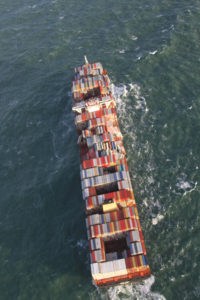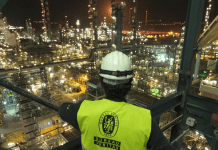
A 19,200TEU ship which lost 342 containers in a North Sea storm hit the seabed as the vessel was tossed up and down in heavy seas according to a report into the MSC Zoe incident published on 25 June.
Dutch Safety Board (OVV) investigations, carried out with input from Germany’s BSU and the Panamanian registry reported the storm conditions were not particularly severe, but that the northwesterly winds that were blowing on the day of the incident in January 2019, meant that the waves were steep and the forces impacting on the cargo containers were massive.
According to the OVV report MSC Zoe was sailing to Bremerhaven on the southern route above the North Sea’s Wadden Islands. The depth of the water is less in this region than the longer northern route, but the report concludes that while the northern route is safer than the shorter southern transit, it remains a difficult path to navigate in the conditions encountered by MSC Zoe on the night of the accident.
As the wide design of the vessel makes it highly stable, rolling will mean that the vessel will roll back to upright quicker than less stable vessels, and with the wave intervals at about the same period of the rolling motion of the ship the forces acting on the lashing equipment are increased further.

“Even though this may sound counterintuitive, this means that large and wide container ships with a high stability have greater roll motions in a beam wave scenario than less stable ships. In addition, a high stability also leads to the effect that the ship wants to return fast to its steady state. This leads to high accelerations and hence large forces on containers and the lashing material on board. The occurrence of contact with the seabed, green water and slamming can further amplify these accelerations and/or forces,” the report explains.
It is less likely that vessels will hit the seabed on the northern route which has deeper water, however, OVV said the “investigation has revealed risks of loss of containers for large, wide container ships on [both] the shipping routes to the north of the Wadden Islands”.
The MSC Zoe investigation concluded that, “The northerly shipping route is from the perspective of container loss not a safe route, at most a less risky route during northwesterly storm conditions. In different conditions the southern route may be less risky.”
Investigators went on to say, “Hydrodynamic phenomena and ship behaviour in shallow shipping routes such as those above the Wadden Islands have only been subjected to limited scientific study. Further research is necessary in order to map out the risks on both shipping routes in other conditions and/or for other ship sizes and types.”
However, the investigation conceded that currently there were no specific guidelines or restrictions for large container ships operating in the comparatively shallow waters to the north of the environmentally sensitive region on the Wadden Islands.
A further admission that “the shipping industry has not established links between the characteristics of large container ships, the specific circumstances to the north of the Wadden Islands,” may see changes to the guidelines as a result of the MSC Zoe accident and pollution.
The Swiss-based carrier said in a statement, “After the incident, MSC made its own decision to avoid the southern sailing route for subsequent voyages and we will continue to follow official guidance on designated container shipping routes in the North Sea, if and when such guidance evolves.”
MSC added it has noted the conclusions of the combined report by OVV, Panama, Germany and the Netherlands, and that the company has fully co-operated with the investigation and is committed to minimising the risk of similar accidents in the future.
Nick Savvides
Managing Editor





